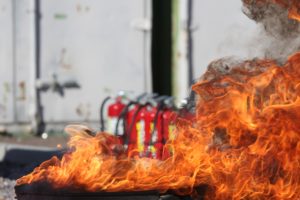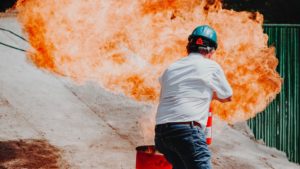 The ultimate test of the decade confronts us today. On the first corner, we have fire sprinklers, water and sand buckets, and fire extinguishers while on the second corner is the newest cutting-edge technology of fire prevention, the Micro Fire Extinguisher Cell Fire Extinguisher (CFE).
The ultimate test of the decade confronts us today. On the first corner, we have fire sprinklers, water and sand buckets, and fire extinguishers while on the second corner is the newest cutting-edge technology of fire prevention, the Micro Fire Extinguisher Cell Fire Extinguisher (CFE).
Will the traditional and normally used fire-extinguishing devices win against the newly invented technological device, or will the new and equipped technology triumph over the outdated methods?
For Round One, we have convenience.
Convenience is judged according to the ease and duration of usage of the extinguishing agent.
Traditional methods vary in convenience.
- Fire buckets containing sand and water are convenient for putting out small-scale fires.
- Fire sprinklers are very convenient as for they work automatically.
- Fire extinguishers are not convenient due to the technical knowledge required in their usage.
On the other hand, the Cell Fire Extinguisher is very convenient.
- Pre-installation allows for automatic activation once heat sensors receive higher heat than designated
- Cell Fire Extinguisher does not require any technical usage.
Verdict: CFE triumphs against certain kinds of traditional fire extinguishing methods (fire extinguishers).
For Round Two is universality.
Universality is judged according to the number of fire classes the extinguishing agent can put out.
Traditional methods are not very universal.
- Fire extinguishers are further divided into classes (according to the extinguishing agent), with each class only able to extinguish a certain class of fire.
- Water-based agents such as fire sprinklers do not fair well against fires from chemicals and electrical devices.
- Fire buckets filled with sand works well for small, kitchen fires.
The CFE is very universal.
- The CFE can extinguish any kind of fire, from electrical to chemical ones.
Verdict: CFE is more universal than any traditional fire-extinguishing method.
Round Three: Area of Coverage
This round will be judged and compared mathematically.
Traditional methods vary in area of coverage.
- Fire sprinklers can cover up to 225 square-feet in light hazard-environments, 130 square feet in ordinary hazard environments Nd 100 square feet in extra hazard environments. (1)
- The maximum recommended travel distance of a class A fire extinguisher is up to 75 meters. (2)
- Fire buckets can smother fires with 9 liters capacity. (3)
The CFE has small coverage per cell.
- Each gram of CFE can extinguish a 0.0013 square meter of fire.
- A cell of CFE contains two grams; that is 0.0026 square meters of fire for CFE.
- CFEs nested together can extinguish fires based on the number of CFEs installed.
Verdict: CFEs have small range compared to traditional methods.
Round Four: Duration of Activation
This criterion will be judged according to the time it takes for the fire extinguishing method to activate and extinguish the fire.
Traditional methods vary in duration.
- Fire extinguishers and fire buckets are human equipment that needs humans for usage. No fire will be extinguished if no human picks up a fire bucket or fire extinguisher and extinguished the fire.
- Fire sprinklers work automatically and activate as soon as the sensors detect the fire/smoke.
CFEs, on the other hand, work in an instant.
- Once the CFE’s sensors reach an external temperature greater than normal, they will quickly activate themselves and release the extinguishing agent.
- CFEs can also be thrown into fires and will quickly release extinguishing agents once in contact with fire.
Verdict: CFEs work significantly quicker than other traditional fire extinguishing methods.
It is a landslide victory, CFEs win three out of four of the rounds and lost one from the four. While the Micro Fire Extinguisher/ Cell Fire Extinguisher (CFE) may have a small range of area covered, it supplied this weakness by working quickly before the fire spreads to an uncontrollable size.
